A recent report by The United Nations Children’s Emergency Fund (UNICEF) on the impact of Boko Haram on children in Chad, Nigeria, Niger and Cameroon offers insight into the devastating effects that the group leaves in its wake.
The report estimates that 1.3 million children were displaced in 2015, an increase of 60% from the year before. The report also details 44 incidents where children were used in suicide attacks in 2015; a massive increase compared with the four reported in the previous year. These shocking numbers challenge us to question how we are taking care of the most vulnerable members of society; those we continue to term as ‘the future’.
While the raw estimates of death, injuries and displacements communicate some of the horror in broad brushstrokes, it is the personal accounts provided by children that truly drive home the appalling realities they face. Video footage of Islamic State (IS) and Boko Haram camps boastfully portray the harsh physical training that children endure as they are prepared to become the next generation of fighters.
A 2015 report by Frontline shows how boys as young as eight and 10 years of age are forced to watch videos of extreme violence, including suicide bombings, and how they are prepared for death in these training camps. In all of these scenarios, there is the constant threat of violence or death to the children or their loved ones.
One 14-year-old boy described his kidnapping by IS from a Syrian anti-government group, his torture by his capturers, and the forced amputation of his arm and leg for refusing to join the group. IS videos have also presented stark footage of young boys performing beheadings.
The impact on millions of children and young people caught up in these circumstances is difficult to comprehend. This is especially true in cases where entire families are subjected to circumstances beyond their control; whether by force, or sometimes by their original choice.
Distinguishing child victims from perpetrators within these complex dynamics is often not possible, nor, in most cases, warranted. Labelling them as ‘child soldiers’ may also be inappropriate. Each situation is different and requires detailed inquiry – especially in cases where children are accused of the worst forms of violence.
Gender and age may also be important factors. The UNICEF report on Boko Haram indicates that young girls seem to be preferred as suicide bombers, with 75% of the reported bombers being from this group. Some of the 276 schoolgirls kidnapped from Chibok in April 2014 have also reportedly been used as suicide bombers.
Are African counter-terrorism approaches designed to understand or respond to these complexities? The international community accepts terrorism as a collection of criminal actions – through instruments such as the United Nations (UN) Global Counter-Terrorism Strategy and other UN resolutions. This is, however, contradicted by the predominant use of force in responses to terrorism in Africa.
Under these circumstances, the imperative to protect children has limited currency, and the use of force can be as indiscriminate as the suicide bombings and other actions adopted by terror groups. More effort and investment should be made in utilising criminal justice responses, rooted in rights-based practices that may complement, or even replace the use of force depending on the circumstances.
Arresting, trying and punishing those found to be culpable are powerful tools for a state to show its ability to promote the rule of law; and for governments to demonstrate their effectiveness.
The international framework for juvenile justice – established by the Convention on the Rights of the Child, and several attendant instruments – provides for the protection of children that come into conflict with the law. The Committee on the Rights of the Child, which monitors and reports on the implementation of this framework, has also issued guidance on matters such as the minimum age of criminal responsibility. The International Labour Organization has established standards defining the use of children to commit crime as one of the ‘worst forms’ of child labour.
It is clear, however, that very few of the African countries affected by terrorism can claim to have comprehensive provisions to protect accused children in justice proceedings (this includes basic issues, such as detaining arrested children separately from adults, to providing legal representation). Much of this can be attributed to limitations in criminal justice systems; in terms of both resources and skills.
The complexity of an accused child’s history and circumstances is difficult to establish without the availability of trained and often expensive personnel, such as social workers, psychologists and specialised investigators. Notably, the parallel ‘welfare’ systems that are intended to support juvenile justice responses – and provide for children and their families requiring supportive services – are often equally weak.
Appropriate responses to children’s involvement in violent extremism are also severely hampered by the fact that counter-terrorism experts, who are security and justice specialists, seldom find themselves in the same rooms as children’s rights specialists. Important efforts have been made in the past year; particularly through the development of ‘good practices’ on juvenile justice and terrorism through the Global Counterterrorism Forum. However, much more needs to be done to effect changes in policy and practice.

